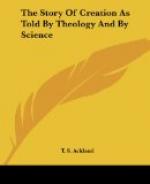Mr. Darwin admits that many other causes, beside the supposed preference on the part of one sex for certain material adornments possessed by the other, influence the pairing of animals. In a very large number of cases the female is quite passive in the matter. The question is decided by a battle between the males, and the female seems, as a matter of course, to become the mate of the conqueror. In many other cases pairing seems to be the result of accident; the two sexes pair as they happen to meet each other. The great points on which Mr. Darwin rests his argument are that in some cases, on the approach of breeding-time, certain ornamental appendages become more highly developed or more brilliantly coloured, [Footnote: Descent of Man, vol. ii. p. 80.] and that in many cases the males, when courting the females, are observed to display their ornaments before them. [Footnote: Ibid. vol. ii. p. 86, et seq.] but then there are other facts, which Mr. Darwin. also notices, which detract more than he seems willing to allow, from the relevancy of these facts. The development of ornaments at breeding-time sometimes takes place in both sexes, indicating some latent connexion with the reproductive organs; thus the comb of the domestic hen becomes a bright red, as well as that of the cock. It would appear then that the object of the change is not to render the cock more attractive to the hens, for how could it serve the hens (if the choice lies with them) to be made more attractive to the cocks? Then again an old hen who is past laying, often assumes, to a considerable extent, the plumage of the cock. When these ornaments are the exclusive possession of the male, they are often displayed for other purposes than the gratification of the female. The possessors seem to be conscious of their beauty, and to take a pleasure in displaying it to any spectators.
Very great beauty and brilliancy of colour is often found in cases in which it can have nothing whatever to do with the relation between the sexes. Thus, a vast number of caterpillars are remarkable for their beauty; but in their immature state it can have no relation to sexual selection; and if it may, or rather must, have a different object in one case, what ground have we for assuming that it may not have a different object in the other?
Again, we are not in a position to form any opinion as to the causes which really influence the pairing of animals when choice is exercised. We have no certain knowledge upon the important question whether the ideal of beauty, if possessed by the lower animals at all, is in all, or even in many cases, in accordance with our own. We, for instance, admire a male humming-bird; what certainty have we that he is equally beautiful in the eyes of his mate? In cases where we have reason to believe that deliberate selection has taken place, we do not know that that selection was influenced by only one condition—that of beauty. There may have been a thousand causes




